This section describes how to configure a network function in LLS-C1 T-BC mode using the Systemd service.
Prerequisites
Create and Apply a Host Profile to a Cell Site Group.
Note:While creating the host profile, add a dedicated PCI Group for each vmnic you want to use for PTP (Server and Client).
Procedure
- Navigate to Catalog > Network Function in the Telco Cloud Automation UI.
- Select the Network Function you want to set up in T-BC mode and click EDIT.

- Click the Infrastructure Requirements tab.

- Add PTP devices under PCI PASS THROUGH:
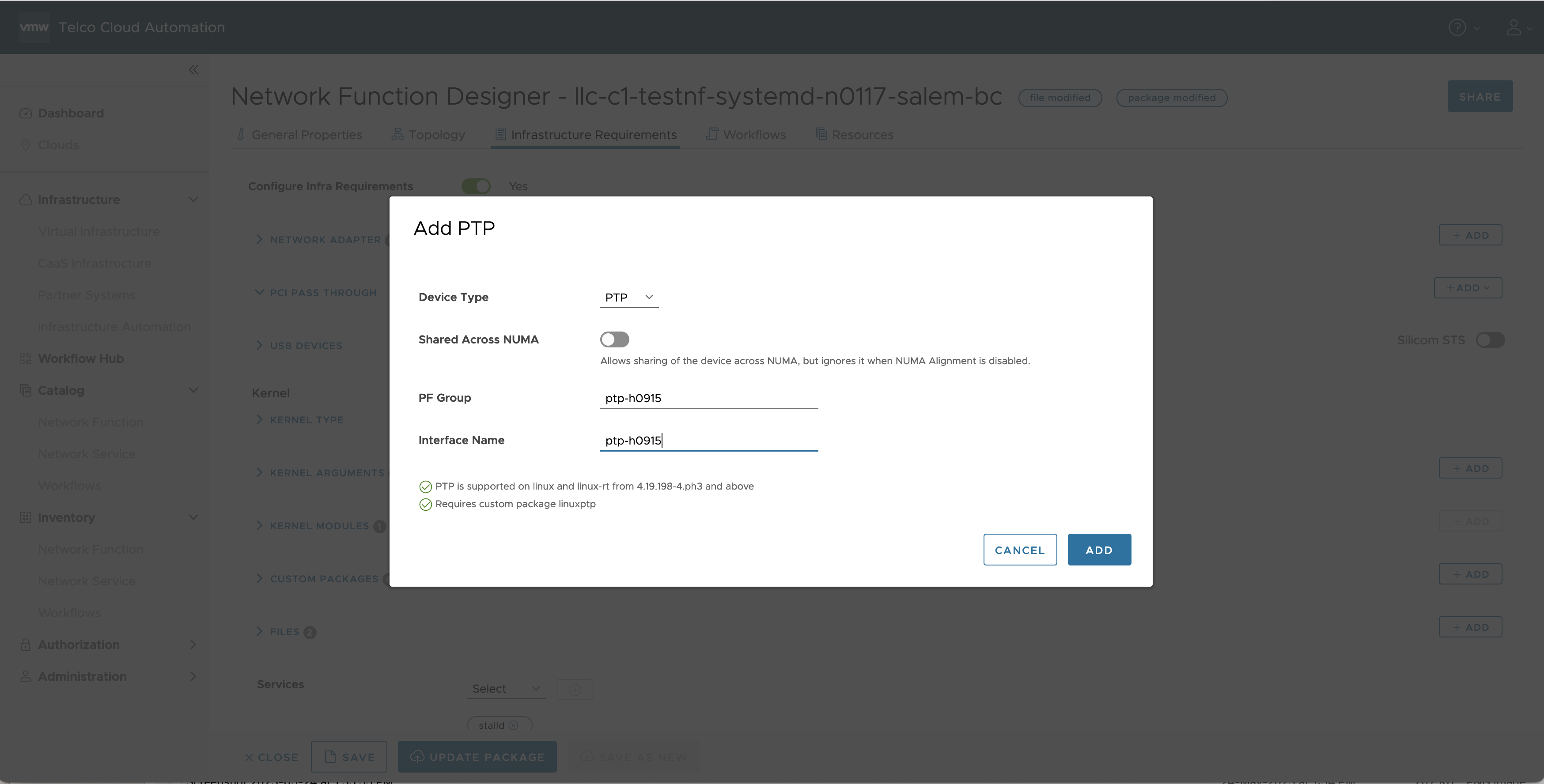
- Click ADD and select PTP from the drop-down list.
- In the Add PTP pop-up window, select PTP as the Device Type.
- Enable or disable Shared Across NUMA as required.
- Enter the name of the PF Group, the PCI Group that you created in the Host Profile. Example: ptp-h0915
- Enter the Interface Name you want to create for this PTP Device on the worker node. Example: ptp-h0915
- Click ADD.
- Repeat steps a-f for each PTP device you want to add.
Note: When you add one or more PTP Devices, an entry for 'linuxptp' gets created in the Custom Packages section. Modify the linuxptp version as required.
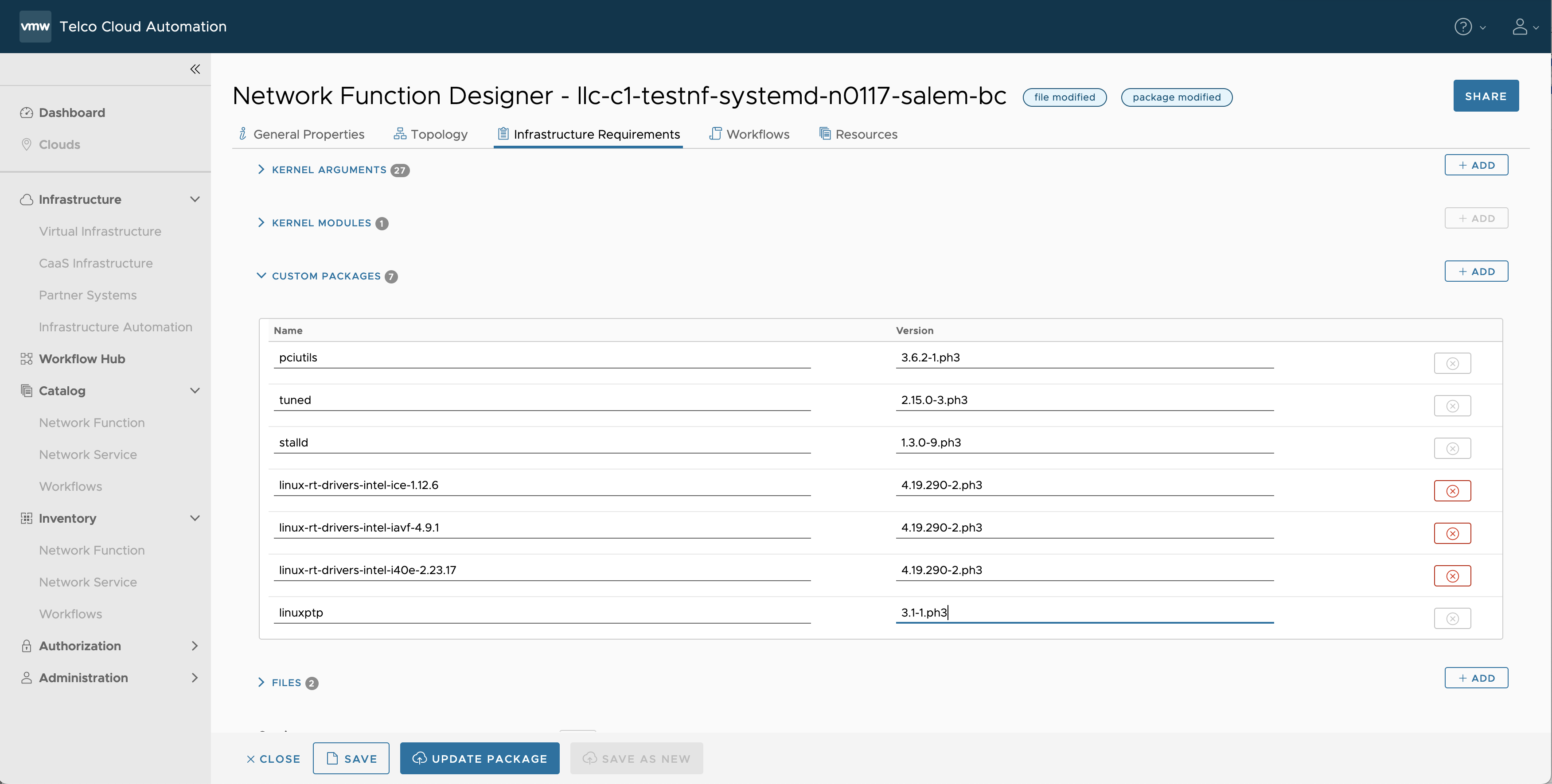
- Click the Resources tab.
- Expand the Artifacts > scripts directory.
Note: If the scripts folder does not exist, create it and then proceed. For instructions to create the scripts folder, see Infrastructure Requirements Designer.
- Add the following configuration files by clicking the + symbol next to 'scripts':
-
phc2sys
OPTIONS="-s ptp -c CLOCK_REALTIME -O -37 -m"
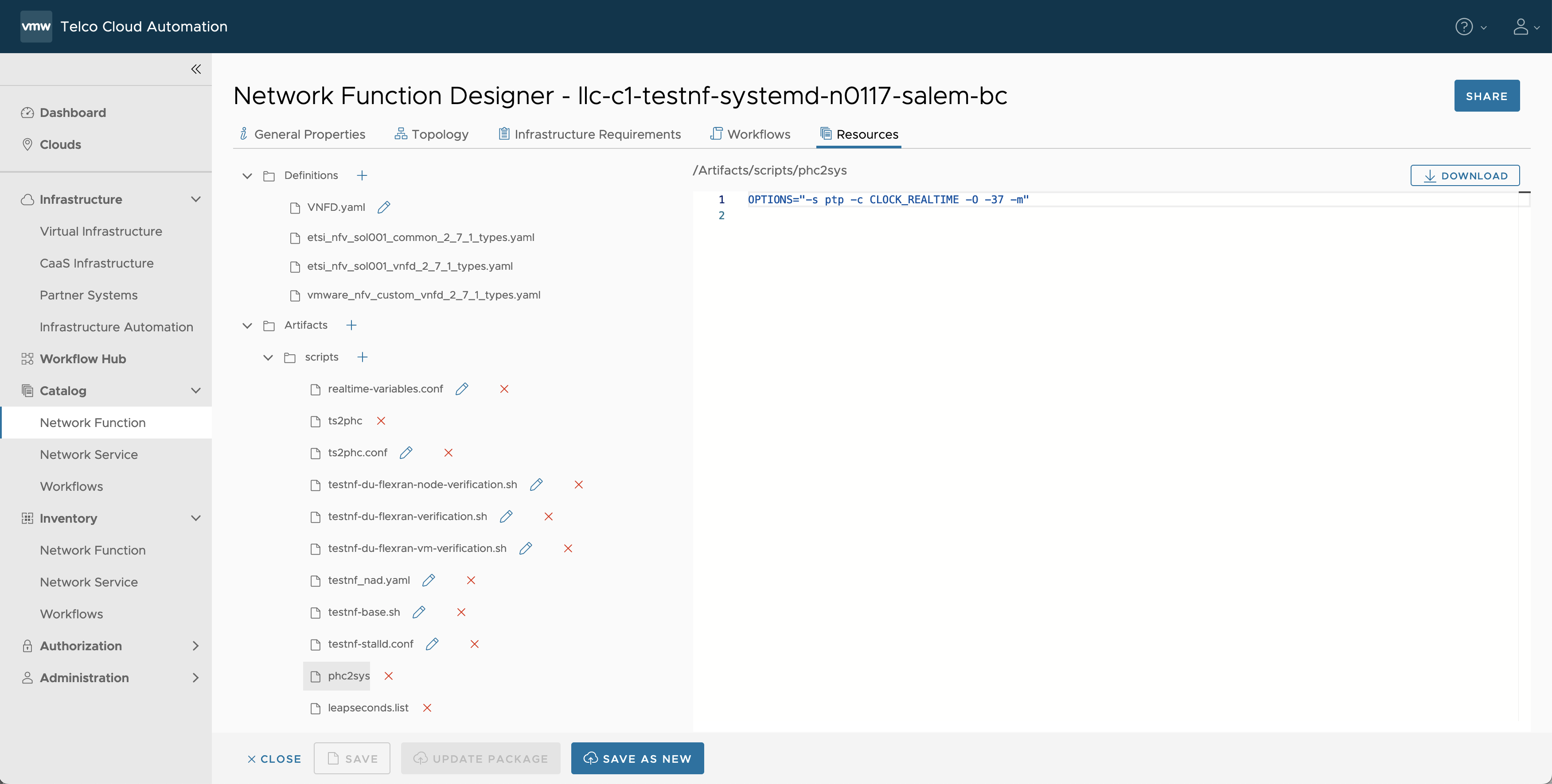
ptp4l
OPTIONS="-f /etc/ptp4l.conf"
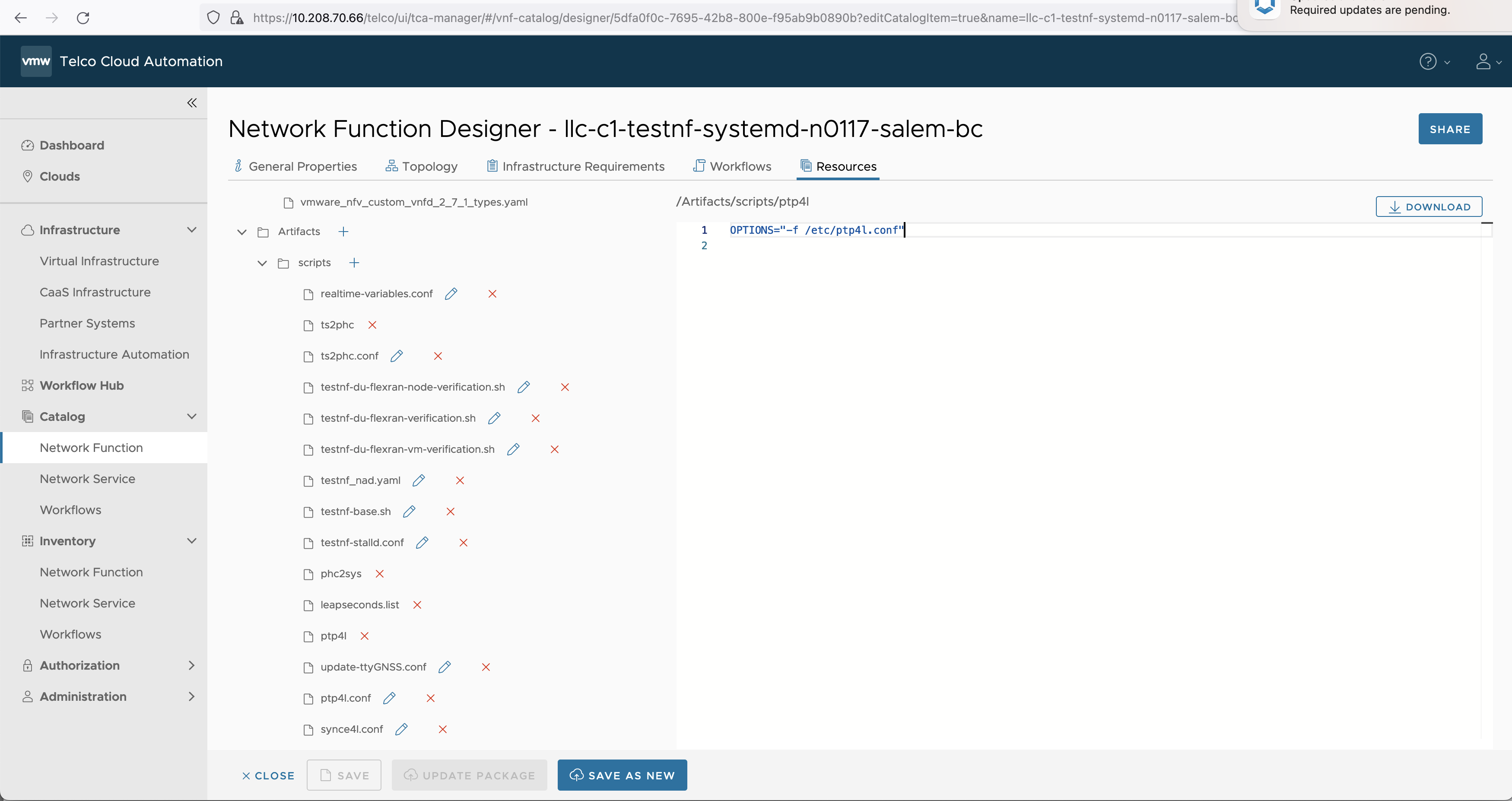
ptp4l.conf
Note: This configuration file is valid for linuxptp version 4.0-2.ph3
[global] # # Default Data Set # twoStepFlag 1 clientOnly 0 socket_priority 0 priority1 128 priority2 128 domainNumber 24 #utc_offset 37 clockClass 248 clockAccuracy 0x21 offsetScaledLogVariance 0xFFFF free_running 0 freq_est_interval 1 dscp_event 0 dscp_general 0 dataset_comparison G.8275.x G.8275.defaultDS.localPriority 128 maxStepsRemoved 255 # # Port Data Set # logAnnounceInterval -3 logSyncInterval -4 operLogSyncInterval 0 logMinDelayReqInterval -4 logMinPdelayReqInterval 0 operLogPdelayReqInterval 0 announceReceiptTimeout 3 syncReceiptTimeout 0 delayAsymmetry 0 fault_reset_interval 4 neighborPropDelayThresh 20000000 serverOnly 0 G.8275.portDS.localPriority 128 asCapable auto BMCA ptp inhibit_announce 0 inhibit_delay_req 0 ignore_source_id 0 # # Run time options # assume_two_step 0 logging_level 6 path_trace_enabled 0 follow_up_info 0 hybrid_e2e 0 inhibit_multicast_service 0 net_sync_monitor 0 tc_spanning_tree 0 tx_timestamp_timeout 300 unicast_listen 0 unicast_master_table 0 unicast_req_duration 3600 use_syslog 1 verbose 0 summary_interval 0 kernel_leap 1 check_fup_sync 0 # # Servo Options # pi_proportional_const 0.0 pi_integral_const 0.0 pi_proportional_scale 0.0 pi_proportional_exponent -0.3 pi_proportional_norm_max 0.7 pi_integral_scale 0.0 pi_integral_exponent 0.4 pi_integral_norm_max 0.3 step_threshold 0.0 first_step_threshold 0.00002 max_frequency 900000000 clock_servo pi sanity_freq_limit 200000000 ntpshm_segment 0 msg_interval_request 0 servo_num_offset_values 10 servo_offset_threshold 0 write_phase_mode 0 # # Transport options # transportSpecific 0x0 ptp_dst_mac 01:1B:19:00:00:00 p2p_dst_mac 01:80:C2:00:00:0E udp_ttl 1 udp6_scope 0x0E uds_address /var/run/ptp4l uds_ro_address /var/run/ptp4lro # # Default interface options # clock_type BC network_transport L2 delay_mechanism E2E time_stamping hardware tsproc_mode filter delay_filter moving_median delay_filter_length 10 egressLatency 0 ingressLatency 0 boundary_clock_jbod 1 # # Clock description # productDescription ;; revisionData ;; manufacturerIdentity 00:00:00 userDescription ; timeSource 0x20 # Name of the interface which is getting # PTP packets from the network. [ptp] serverOnly 0 # interface's connected to RUs [ptp-h0915] serverOnly 1
Note: In the following ptp4l.conf file content, you can notice the interface name that you added in Step #4. In this example, only one RU is connected, so there is only one entry 'ptp-h0915'. If multiple RUs are connected, you need an entry for each RU (similar to ptp-h0915).
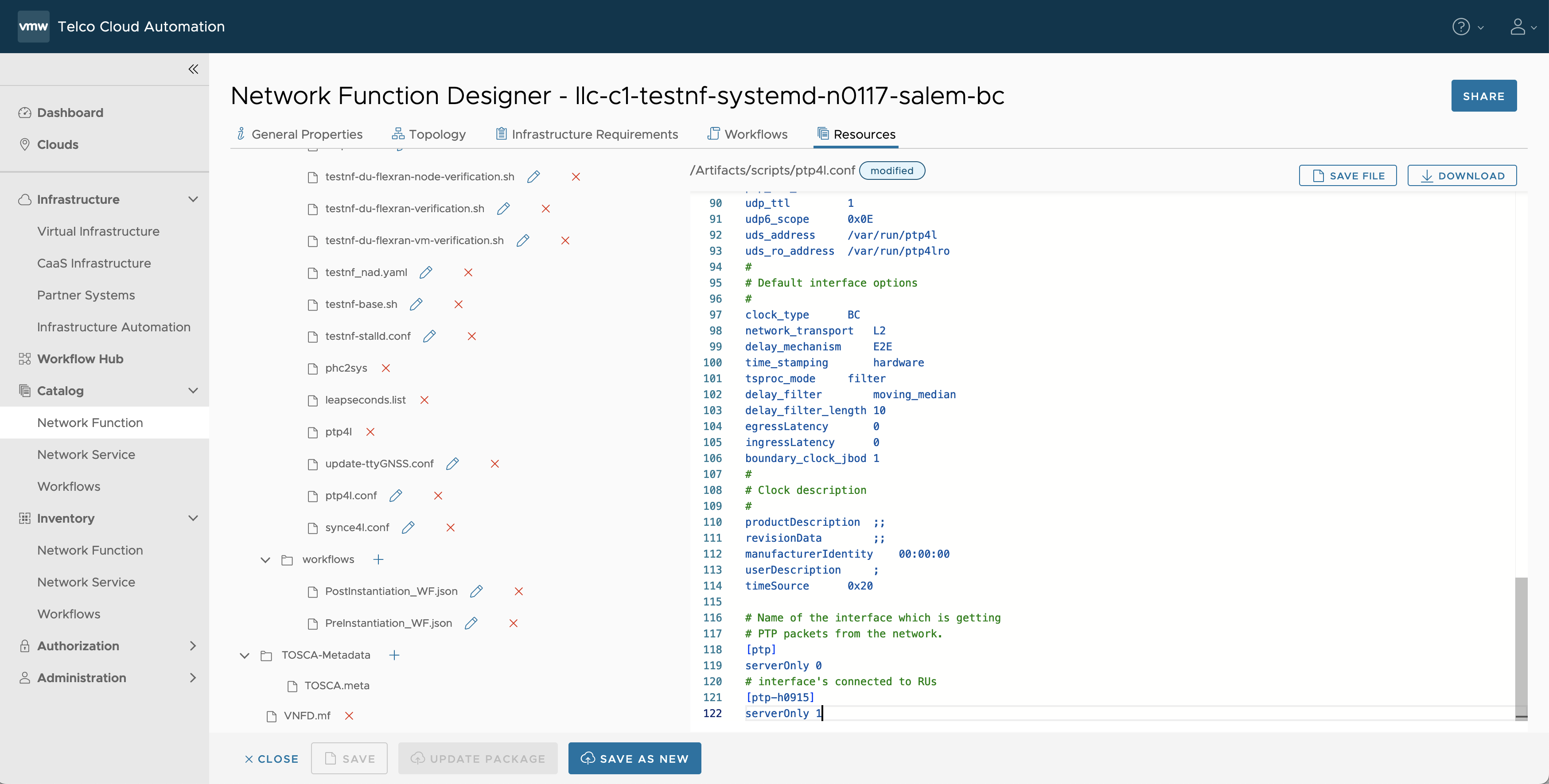
-
- Save the CSAR by clicking SAVE.
- Click UPDATE PACKAGE or SAVE AS NEW as appropriate.
- Click CLOSE.
- Instantiate the network function.